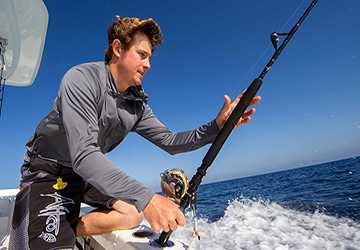How to Master the Art of Deep-Sea Fishing
The vast expanse of the open sea, the gentle rocking of the boat, and the anticipation of what lies beneath the surface - these are the elements that make deep-sea fishing an irresistible adventure for many. It's a pursuit that offers a unique blend of tranquility and excitement, and the best part is you don't need to be a seasoned pro to enjoy it.
Whether you're a newcomer to the world of fishing or a seasoned shore angler looking to expand your horizons, deep-sea fishing is within your reach. In this guide, we'll take you on a journey through the art of the marine fishery, breaking down the steps and techniques in a way that's easy to grasp.
Getting Started with Deep-Sea Fishing
Deep-sea fishing may sound like something only experienced anglers do, but truth be told, it's accessible to anyone with a passion for the ocean. The first step is getting the right gear. Invest in a sturdy fishing rod and reel, preferably one designed for saltwater.
These are built to withstand the corrosive effects of the sea. You'll also need a variety of hooks, sinkers, and lures to attract different fish species. Safety is paramount, so remember life jackets, sunscreen, and a first-aid kit. Check the weather forecast before you head out, and always let someone on land know your fishing plans and expected return time.

Choosing the Right Location
Location is everything in deep-sea fishing. Different fish species prefer different habitats. If you're new to this, consider booking a charter with an experienced captain who knows the local waters. They'll take you to the best spots where fish are abundant.
However, if you're more adventurous and want to go solo, research the area you plan to fish in. Look for underwater structures like reefs, shipwrecks, or drop-offs. These are prime spots for fish to gather. You can also ask local fishermen or visit online forums for insider tips on where the fish are biting.
Understanding Tides and Currents
Tides and currents are the ocean's heartbeat and greatly influence fish behavior. Fish tend to feed more actively during tide changes when the water movement stirs up prey. Understanding the tide schedule for your chosen location is crucial.
You can find tide charts online or at local fishing shops. Plan your fishing trip around the incoming or outgoing tides for better success. Strong currents can make fishing challenging, so be mindful of their intensity. Fishing during slack tide, when winds are minimal, can be a good strategy.
Bait and Lures
Now, let's talk about bait and lures. Fish aren't too picky, but they do have preferences. Live bait like shrimp, squid, or small fish works well for many species. However, artificial lures can also be more effective and convenient. Choose lures that mimic the prey fish in the area you're fishing.
Experiment with different colors and sizes until you find what works best. Remember that some days, fish might prefer live bait, while on others, they'll go for lures. It's all part of the adventure.
Patience Is Key
Deep-sea fishing isn't a sprint; it's a marathon. You might wait hours for that big catch, so patience is your best friend. While you wait, enjoy the open sea's beauty and the unknown's thrill. Remember that even if you don't catch a trophy fish, every trip is a learning experience.
Sometimes, the journey, not just the destination, makes deep-sea fishing rewarding. So, bring a good book, some snacks, and a positive attitude to make the most of your time on the water.
Mastering the Art of Knot Tying
Knot tying is an essential skill for any angler. You don't want to lose that prized catch due to a poorly tied knot. The Palomar knot is reliable for securing hooks, lures, and swivels. It's easy to learn and has a high breaking strength.
Practice tying knots until you can do it with your eyes closed (not recommended, but you get the idea). When you land that monster fish, you'll thank yourself, and your knot is strong.

Handling and Releasing Fish
Catch and release is a responsible practice in deep-sea fishing. If you don't plan to keep the fish, handle it carefully. Wet your hands before touching the fish to minimize damage to its protective slime layer.
Use a dehooking tool to remove hooks safely. If the fish is tired from the fight, gently support it in the water until it's ready to swim away. Proper catch and release ensure healthy fish populations for future generations of anglers.
Cleaning and Cooking Your Catch
If you keep your catch, it's time to clean and cook it. Cleaning fish can be messy, so be prepared with a sharp knife and a clean workspace. Remove scales, gut the fish, and rinse it thoroughly.
There are countless ways to prepare your fresh catch. Grilling, baking, or frying are popular choices. Experiment with different recipes and flavors to find your favorite. Nothing beats the taste of a fish you caught yourself.
Conservation and Respect for the Ocean
Finally, let's talk about conservation. Deep-sea fishing is a beautiful hobby, but it's essential to do it responsibly. Follow size and bag limits to protect fish populations. Dispose of trash properly and pick up any litter on your trips.
Respect the ocean and its inhabitants. It's a fragile ecosystem, and we must do our part to preserve it for future generations. By practicing sustainable fishing and spreading awareness, you can help ensure that deep-sea fishing remains a cherished pastime for years to come.
Conclusion
Mastering the art of deep-sea fishing is a journey that combines preparation, knowledge, patience, and respect for the environment. With the right gear, location, and techniques, you can embark on unforgettable adventures and bring home not just fish but memories that will last a lifetime. So, gear up, head out to the open sea, and let the thrill of deep-sea fishing capture your heart.




















